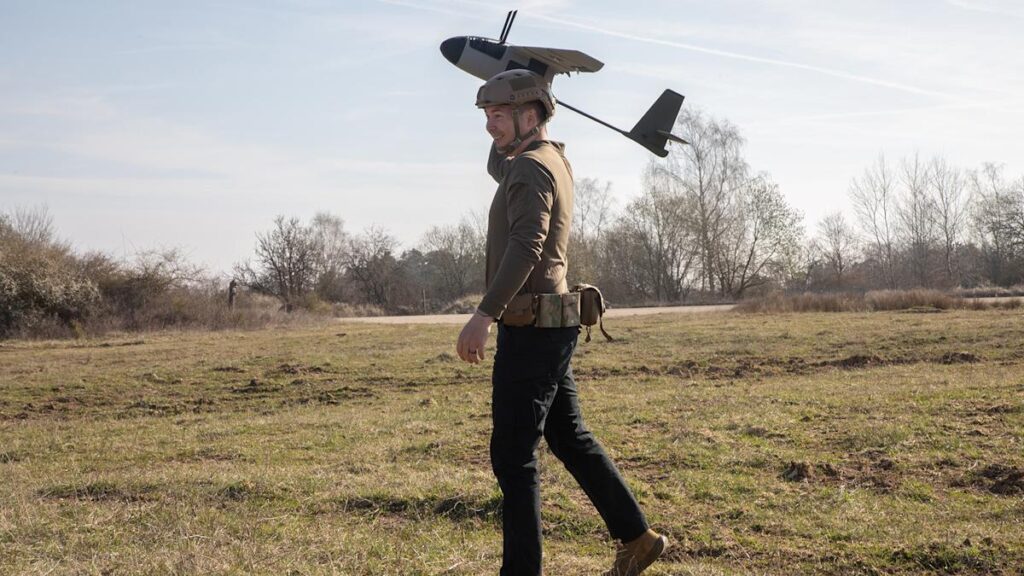The Army plans to test 3D-printed drones next month during an exercise in Poland to see if the service can mass produce its own small unmanned aerial systems at a much lower cost than the defense industry, Army officials told Task & Purpose.
The 2nd Multi-Domain Effects Battalion based in Mainz-Kastel, Germany, has built about seven small drones, which have sensors to scan the electromagnetic spectrum to find targets, like “The Predator” from the movie franchise, the officials said on Friday.
The Task Force will send one or two of the 3D-printed drones to the exercise in Poland to test their ability to help soldiers identify simulated threats, said Lt. Col. Aaron Ritzema, commander of the battalion, which is tasked with conducting long-range reconnaissance missions in the European theater.
“The main way that I see adversaries is through their electromagnetic signature,” Ritzema told Task & Purpose. “So, a lot of the threat replication that we do — rather than making a cardboard or a wooden tank to go see, really what I want to do is replicate what one of those adversary capabilities would look like in the spectrum.”
The drones are designed to look for cell phones, routers, Blue Tooth, WiFi, radars, and other electromagnetic signatures that cannot be detected with a camera alone, said Chief Warrant Officer 2 Chris Lehr, the team lead for the battalion’s innovation lab.
The ongoing conflict between Russia and Ukraine has shown both the Army and Defense Department just how important unmanned aerial systems are on modern battlefields, Lehr told Task & Purpose.
“What we know to be true now is that there are never enough of them,” Lehr said. “There’s never enough of them on the forward line of troops. There’s never enough of them in production.”
The drones are very much a work in progress, Lehr said. The first tests about two weeks ago did not go well, but the lab was able to learn from its mistakes by revamping the drones’ frames and making other changes. Subsequently, the lab has conducted more than 10 successful tests.
Lehr said the lab is trying to demonstrate to the rest of the Army how soldiers can build small drones for between $2,000 to $3,000, compared with a commercially built quad copter that can cost up to $28,000.
Learning how to 3D print the components for the drones has been “quite a journey,” said Sgt. 1st Class Tyler Baumgartner, the innovation lab’s noncommissioned officer in charge.
The Army tests a 3-D printed drone at Joint Multinational Readiness Center, Hohenfels training area, Hohenfels, Germany, on April 11, 2025. Army photo by Pfc. Brent Lee.
Baumgartner said he had to learn how to get the right quality of print for the drones, and how to make sure the airframe is the right weight and strong enough to fly.
“Everything has been self-taught, through Chief Lehr and I, where we have stumbled upon an issue, and either we sourced to friends and partners for a solution, or we spent a copious amount of hours self-studying to develop a solution on our own,” Baumgartner told Task & Purpose.
So far, the most difficult aspect of building the drones has been the lengthy process required to get parts approved by the Defense Department, which also increases the cost of each drone, Lehr said.
“When we say we produced seven aircraft in eight months, at least 90 to 120 days of that was just waiting on paperwork to be completed so we can actually put these things in the air,” Lehr said.
While the parts used for the drones are available commercially, they are required to be produced by certain countries, Ritzema said.
“There are some restrictions in terms of where those parts come from that kind of force us to use sometimes the least economically viable solution to actually get that in our hands,” Ritzema said.
When asked if that means the lab can’t buy parts made from China, Ritzema replied, “Something like that.”
“Even though we’re not doing this at scale or at range that we would in an operational environment, our ability to do this by ourselves in advance of the Army fielding this capability is absolutely foundational to our ability to actually fight this formation in the future,” Ritzema said.
The latest on Task & Purpose
Read the full article here


